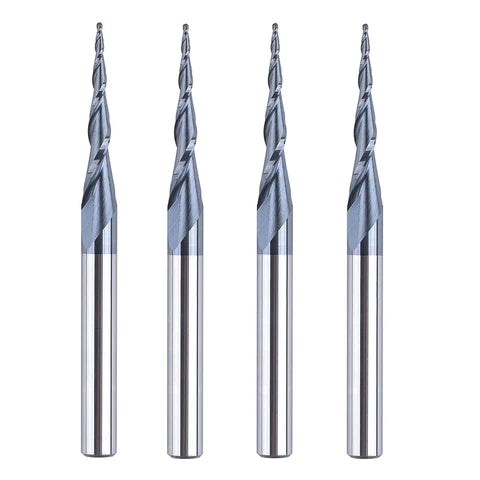5 Essential Tips For Choosing The Right End Mill Bit
The ideal end mill is the one that matches your cutting requirements with the available tooling. If a particular material requires a different end mill from what is normally used for it, then a special milling cutter should be made. These cutters are also known as end mills and are unique tools that help milling operations in specific materials much easier and faster.

Most of these cutting tools are very expensive and require specialized machinery to make them. However, there are many mills that can be made at home that have the desired cutting properties required for the job. In this blog, we will discuss some of the most common end mills and their cutting characteristics. We will also touch upon some of the applications of these mills, and you will see how they can be used in various industries.
Types of End Mill Bits
End mill bits are essential cutting tools for any machining project, and selecting the right type of end mill bit is crucial for achieving high-quality results. There are numerous types of end mill bits available, each designed for specific cutting applications, materials, and workpiece geometries.
Here are some of the most commonly used end mill bits:
Ball End Mills: These end mills have a rounded cutting edge that is perfect for creating curved or contoured surfaces. They are also ideal for 3D machining applications and can be used to create complex shapes and contours.
Square End Mills: These end mills have a flat cutting edge and are ideal for creating flat surfaces and sharp corners. They are commonly used in milling operations that require a high degree of accuracy and precision.
Corner Radius End Mills: These end mills have a rounded corner that reduces chipping and creates smoother cuts. They are ideal for creating rounded edges and corners on workpieces.
Roughing End Mills: These end mills are designed for rapid material removal and have fewer flutes and a high helix angle. They are excellent for roughing operations that require high-speed cutting and can quickly remove material from workpieces.
Chamfer End Mills: These end mills have an angled cutting edge and are used for creating bevels and angled cuts. They are ideal for creating chamfered edges and can also be used to create complex shapes and contours.
In addition to the type of end mill bit, several factors should be considered when selecting the right one for your project. These include the material of the workpiece, the type of cutting required, the length and diameter of the tool, the coating, and the quality and brand of the end mill bit. By taking these factors into consideration, you can choose the right end mill bit for your project and achieve high-quality results.
Length Categories
End mill bits come in various categories of length, suitable for different machining applications. Long length end mills are ideal for machining operations where the bit requires more reach and clearance. Reduced neck end mills are compact and ideal for tight spaces and fine machining work. Standard length end mills are also available in different flute styles to suit your needs. Corner radius end mills are available in sizes ranging from .031" to 1 inch, suitable for a variety of cutting applications. Miniature end mills are also available and are ideal for use in steels, stainless steels, cast irons, and other high temperature alloys. Whether you're looking for long or short length end mill bits, our online store has a wide range of options to suit your needs.
Tips For Choosing The Right End Mill Bit
End mills are an indispensable tool in the machining process, and choosing the right type of end mill bit is critical for achieving high-quality results. With a wide range of end mill bits available in the market, selecting the right one can be a daunting task, especially for those new to the field. In this article, we will provide five essential tips for choosing the right end mill bit to help you make an informed decision.

Consider the Material of the Workpiece
The first and most crucial factor to consider when selecting an end mill bit is the material of the workpiece. Different materials require different types of end mill bits. For example, if you are working with aluminum, a high-speed steel (HSS) end mill bit is ideal, while a carbide end mill bit is recommended for cutting through hardened steel.
It is essential to understand the properties of the material you are working with to select the right end mill bit. Factors such as the hardness, toughness, and heat resistance of the material will affect the selection of the end mill bit.
Determine the Type of Cutting Required
The type of cutting required is another critical factor to consider when selecting an end mill bit. Different cutting requirements, such as roughing, finishing, and profiling, require different types of end mill bits. For example, a roughing end mill bit with fewer flutes and a high helix angle is ideal for rapid material removal, while a finishing end mill bit with more flutes and a lower helix angle is better suited for achieving a smooth finish.
It is essential to understand the type of cutting required to choose the right end mill bit that will optimize your project's cutting performance.
Consider the Length and Diameter of the Tool
The length and diameter of the tool are also important factors to consider when selecting an end mill bit. The length of the tool affects its rigidity and its ability to reach tight spaces, while the diameter of the tool determines its cutting speed and accuracy. For example, a longer end mill bit with a smaller diameter is ideal for deep pockets, while a shorter end mill bit with a larger diameter is better suited for wide-open areas.
Choose the Right Coating
End mill bits are coated with different materials to enhance their performance, such as increasing their hardness, lubrication, and heat resistance. There are various coatings available, such as TiN, TiCN, TiAlN, and AlTiN, each with unique properties.
It is crucial to choose the right coating based on the material of the workpiece and the type of cutting required. For example, TiN coating is suitable for cutting aluminum and other non-ferrous metals, while TiAlN coating is better suited for cutting stainless steel and other high-temperature alloys.
Invest in Quality End Mill Bits
Lastly, investing in quality end mill bits is essential for achieving high-quality results. Quality end mill bits are made of high-grade materials, have precise tolerances, and are manufactured to strict standards. Cheap end mill bits may seem like a cost-effective option, but they may not provide the same level of performance and accuracy as quality end mill bits.

Conclusion
End mill bits are cutting tools that can be used to reduce the overall length of a cutting operation. They are often used to reduce taper and improve surface finish. There are many types of end mill bits, and they can vary in size and shape. Depending on the application, end mills can be made from various materials, including carbide and titanium. Regardless of their shape or material, end mills all work in the same way: by cutting into a workpiece. As stated earlier, end mill bits are commonly used to reduce taper and improve surface finish while cutting. While they may not be as widely used as ball or crowfoot end mill bits, they do have their place when cutting needs arise. It’s essential to consider which type of bit is best for your job before starting cutting operations using any tool. Read more here: https://www.mafordepot.com/blog/quality-end-mills-low-prices-and-fast-shipping This blog was written by MAFORDESIGN Specialists - ‘a Design company specializing in End Mills!’
Frequently Asked Questions
What is the difference between a boring and end mill cutter?
A boring or end mill cutter has different flutes that help it to cut through a workpiece faster and more accurately. The flutes are tiny cuts in the tool's cutting edge that create spinning blades of sawdust and chips as the tool moves along the workpiece. This process makes the cutter much more efficient than a standard carbide-tipped blade, and it also produces less dust and chips. End mill cutters are typically used for machining the sides or faces of a workpiece, while boring cutters are limited to axial milling operations. End mill cutters can be used for axial and radial milling operations, while boring cutters are limited to axial milling operations.
Does an end mill bit really work?
Yes, end mill bits do work. However, before using them, please make sure to read up on the different types of end milling procedures and their specific benefits. End milling is a type of machining operation that uses helical rotating cutting tools to perform various tasks like end milling, conventional milling, climb milling, peripheral milling, plunge cutting, and ramp cutting. Newer end mills are designed with features such as corner chamfer and chipbreaker to improve chip evacuation and reduce tool engagement. Inserted cutting tools are becoming increasingly common as they reduce tool-change times and allow for the easy replacement of worn or broken cutting edges rather than the entire tool.
How can I choose a right end mill cutter for my job application?
When choosing an end mill cutter for your job application, be sure to take into account the size, shape, and material of the job application. Additionally, consider the carbide cutting tool manufacturer's wide selection of inventoried products at a good price and with a good reputation. Finally, consult with a carbide cutting tool manufacturer for guidance in selecting the right end mill for the job.
References:




